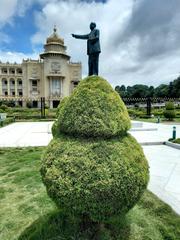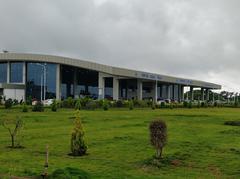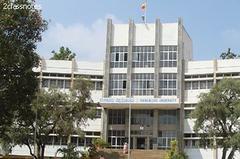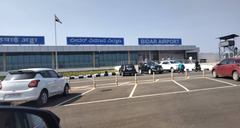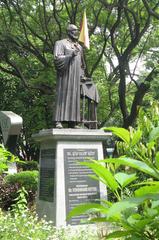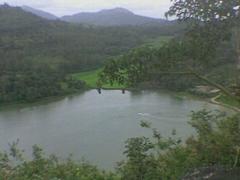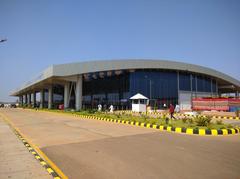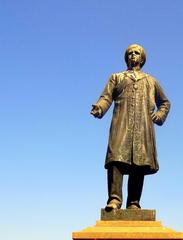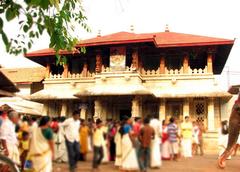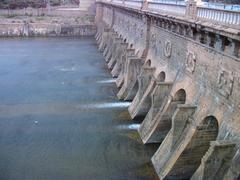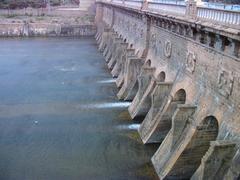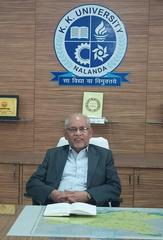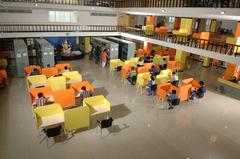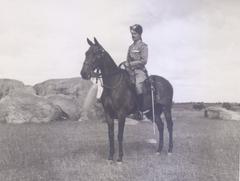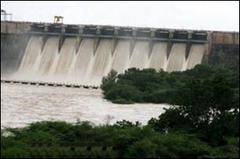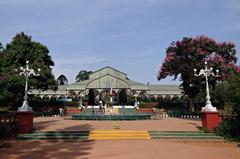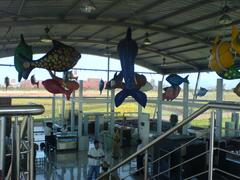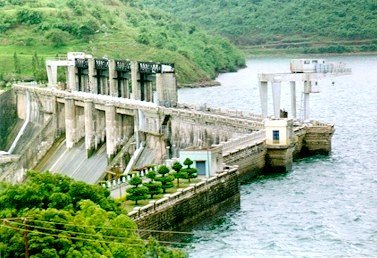
Bhadra Dam Visiting Hours, Tickets, and Travel Guide | Karnataka, India
Date: 15/06/2025
Introduction
Bhadra Dam, completed in 1965, stands as a symbol of Karnataka’s progressive approach to sustainable development through advanced irrigation, hydroelectric power, and water management. Located near Lakkavalli village in the lush foothills of the Western Ghats, Chikkamagaluru district, this earthen dam with a masonry spillway harnesses the perennial Bhadra River. The dam is pivotal for regional agriculture, industry, and ecology, irrigating over 162,818 hectares and supporting hydroelectric generation. Its establishment has transformed the socio-economic landscape of Shivamogga and Chikkamagaluru districts (BangaloreOrbit; InstaPDF).
Surrounded by the Bhadra Wildlife Sanctuary—a Project Tiger reserve—Bhadra Dam is also an ecological hotspot. The sanctuary is home to Bengal tigers, elephants, leopards, and over 250 bird species. Its reservoir islands are crucial habitats for migratory birds, making the site a haven for nature and wildlife enthusiasts (Karnataka Tourism; theholidaystory.com).
Visitors can enjoy activities such as boating, birdwatching, jeep safaris, and photography, with convenient road access and eco-friendly accommodations like the River Tern Lodge nearby (TravelSetu). The dam is open every day, generally from early morning to evening, and entry is free for general visitors, though tickets are required for safaris and sanctuary access. The best time to visit is from October to March, offering pleasant weather and frequent wildlife sightings (Chikmagalur Tourism).
This guide provides comprehensive information for travelers and nature lovers—including historical context, geographical features, visitor amenities, and nearby attractions—to help you plan a memorable visit to one of Karnataka’s most treasured sites.
Historical Background
The Bhadra Dam, constructed across the Bhadra River—which originates in the Western Ghats at Gangamoola near Kudremukh—was part of India’s mid-20th-century push for multi-purpose infrastructure (BangaloreOrbit). Completed in 1965, it was designed to meet irrigation, water supply, and power generation needs. The Bhadra flows into the Tungabhadra River, a vital waterway for Karnataka (InstaPDF), and the dam leverages the region’s heavy monsoon rainfall to support agricultural and industrial development.
Socio-Economic and Environmental Impact
Bhadra Dam transformed local agriculture by irrigating vast tracts of farmland, supporting crops like paddy and sugarcane, and catalyzing economic growth in industries such as those in Bhadravathi. The reservoir’s catchment area also evolved into the Bhadra Wildlife Sanctuary, later a Project Tiger reserve, covering about 500 sq km and supporting a rich diversity of flora and fauna (Karnataka Tourism).
Geographical Setting
Location and Accessibility
Bhadra Dam is near Lakkavalli village, about 38 km from Bhadravathi and 78 km from Chikkamagaluru, at the sanctuary’s northern edge. The dam is easily reached by road, with the nearest railway station at Kadur Junction (51 km) and the closest airport in Mangalore (185 km) (Karnataka Tourism).
Hydrological Features
The dam’s earthen structure, with a masonry spillway, is 1,700 meters long and 59.13 meters high, forming a reservoir with a 2.03 billion cubic meter capacity (InstaPDF). The catchment receives about 2,300 mm rainfall annually, and the reservoir’s islands boost its scenic and ecological value.
Ecological Zones
The Bhadra basin comprises:
- Surplus Region: Upper river stretches, dense forests.
- Controlled Flow: Downstream, regulated for irrigation and power.
- Deficit Region: Farther downstream, with seasonal water scarcity (BangaloreOrbit).
Climate
The region is tropical, with heavy rains from June to September and pleasant weather (15°C–28°C) from October to March (Karnataka Tourism).
Visitor Information
Visiting Hours and Tickets
- Dam Hours: 6:00 AM to 4:00 PM daily (Chikmagalur Tourism)
- Entry Fee: No fee for dam entry; safaris and activities have additional charges.
- Wildlife Sanctuary: Open 6:00 AM to 6:00 PM; entry fees INR 50–100 for Indians, INR 200–300 for foreigners.
- Boating & Safaris: Timings align with dam hours; safari slots are typically 6:30–8:30 AM and 4:00–6:00 PM (Solopassport).
Accessibility and Facilities
Bhadra Dam is accessible by car, bus, or taxi. Facilities include parking, restrooms, and some wheelchair-accessible areas. Mobile connectivity may be patchy in forested zones.
Accommodation
Options range from eco-resorts (e.g., River Tern Lodge) to homestays and guesthouses in Lakkavalli, Tarikere, and Chikmagalur (Solopassport). Advance booking is recommended.
Activities and Experiences
Boating and Water Sports
Boating, kayaking, sailing, and water cycling are offered on the reservoir, with panoramic views of the Western Ghats and opportunities to see migratory birds (Rangataana; TravelTriangle).
Wildlife Safaris and Nature Walks
Jeep safaris in the Bhadra Wildlife Sanctuary are available via the Forest Department, providing chances to spot tigers, elephants, leopards, and rich birdlife (Solopassport).
Picnics and Relaxation
Scenic picnic spots with forested hills and tranquil waters are ideal for relaxation. Carry your own food and water, as amenities are limited.
Ecological and Conservation Significance
Bhadra Dam and Sanctuary are biodiversity hotspots within the Western Ghats (bynekaadu.com). The sanctuary is home to:
- Mammals: Tigers, elephants, leopards, gaurs, sloth bears, wild dogs, sambar and barking deer, giant squirrels.
- Birds: Over 250 species, including Malabar hornbill, river tern, paradise flycatcher (karnataka.com).
- Butterflies/Invertebrates: Crimson Rose, Baronet, Bamboo Brown, and more (theholidaystory.com).
The dam’s wetlands aid groundwater recharge, regulate floods, and sustain aquatic life, while forest conservation and Project Tiger initiatives have enhanced wildlife populations (holidaymonk.com).
Cultural and Community Importance
Temples such as the Mhakta Markandya and Bhavani Shankar near the dam add spiritual depth (theholidaystory.com). The dam supports local livelihoods through agriculture, tourism, and employment in eco-resorts (karnataka.com), while festivals like Ugadi and Sankranti enliven village life (Rangataana).
Practical Travel Tips
- Best Time to Visit: October–March for ideal weather and high water levels.
- Clothing: Comfortable, weather-appropriate attire and sturdy footwear.
- Wildlife Etiquette: Maintain quiet, avoid littering, do not feed animals.
- Safety: Be cautious near water, especially after heavy rainfall.
- Connectivity: Inform others of your plans if venturing into remote areas.
- Cuisine: Enjoy local Karnataka dishes such as akki rotti and neer dosa at nearby towns or resorts.
Nearby Attractions
- Bhadra Wildlife Sanctuary: Tiger reserve and biodiversity hotspot (Solopassport).
- Kemmangundi: Hill station known for trekking and views.
- Hebbe Falls & Kallathigiri Falls: Scenic waterfalls (TravelSetu).
- Mullayanagiri Peak: Highest in Karnataka, trekking destination.
- Shivappa Nayaka Palace: Historic site in Shimoga.
Sustainability and Responsible Tourism
Visitors should minimize waste, respect local customs, and support eco-friendly initiatives. Conservation is vital to preserve the dam’s ecological functions and biodiversity (Chikmagalur Tourism).
Frequently Asked Questions (FAQs)
Q: What are the Bhadra Dam visiting hours?
A: 6:00 AM to 4:00 PM daily.
Q: Is there an entry fee?
A: No fee for dam entry; charges apply for boating and wildlife safaris.
Q: How do I reach Bhadra Dam?
A: By road from Shimoga, Tarikere, or Chikmagalur; nearest rail at Kadur Junction; nearest airport at Mangalore.
Q: Are accommodations available nearby?
A: Yes, options include River Tern Lodge, eco-resorts, homestays, and guesthouses.
Q: What is the best season for visiting?
A: October to March for pleasant weather and lush scenery.
Q: Are safaris available?
A: Yes, jeep safaris are offered in the wildlife sanctuary.
Visuals and Interactive Elements
Enhance your trip planning with images of the dam, boating, wildlife, and historical sites. Use interactive maps or virtual tours on official tourism platforms for location guidance and itinerary planning.
Conclusion
Bhadra Dam exemplifies the union of engineering achievement, ecological excellence, and cultural richness in Karnataka’s Western Ghats. With abundant wildlife, scenic landscapes, and nearby historic attractions, it is a must-visit for nature lovers and travelers seeking a holistic experience. Plan your journey between October and March, book accommodations in advance, and practice responsible tourism to help preserve this unique destination.
References
- BangaloreOrbit
- InstaPDF
- Karnataka Tourism
- TravelSetu
- Karnataka.com
- The Holiday Story
- HolidayMonk
- Chikmagalur Tourism
- Solopassport
- Rangataana
- TravelTriangle
- bynekaadu.com
- holidify.com
- Trawell.in


